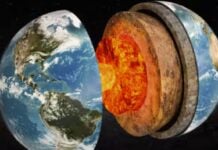
Researchers from China have confirmed the existence of an approximately 8.5-year Inner Core Wobble (ICW) in both polar motion and length-of-day variations, revealing a static tilt of about 0.17 degrees between the Earth’s inner core and mantle, challenging traditional assumptions and providing insights into the Earth’s internal dynamics and density distribution.
The Earth’s inner core is a solid, dense sphere composed primarily of iron and nickel. Located beneath the liquid outer core, it spans a radius of about 1,200 kilometers (746 miles). This region plays a crucial role in Earth’s geophysical processes, influencing the planet’s magnetic field and contributing to the overall dynamics of the Earth’s interior.
Understanding the properties and behavior of the inner core is essential for unraveling mysteries related to Earth’s structure, seismic activity, and magnetic field.
The ICW refers to the wobbling motion of the Earth’s inner core around its rotation axis. This phenomenon is characterized by a periodic oscillation of the inner core’s figure axis.
A new study has confirmed that the ICW of Earth has a periodic motion with a cycle lasting approximately 8.5 years. This wobbling motion has been observed in measurements of polar motion, the Earth’s rotational axis’ periodic movement and length-of-day variations (ΔLOD), and the changes in Earth’s rotational speed.
Professor Hao Ding, co-author of this research and Dean of the Geophysics Department at Wuhan University, was inspired by the unconventional density structures revealed in Earth’s free oscillation.
He told Phys.org, “My then Ph.D. student, Dr. Yachong An, and I discovered an 8.5-year signal in PM and ΔLOD, prompting us to conduct the present study.”
Earth’s free oscillation and rotation
The Earth has four layers — the crust, the mantle, the outer core, and the inner core.
Traditionally, our understanding of Earth’s rotation has been anchored in the assumption of a uniform density distribution in the mantle and core along the radial direction (extending from the center outwards). This assumption leads to the belief that the rotation axis of the Earth’s core coincides with that of the mantle.
“However, results of the Earth’s free oscillation (natural oscillations of Earth as a whole) indicate that the density structures of the Earth’s interior are highly heterogeneous, so this assumption should not be realistic,” explained Dr. Ding.
When Professor Ding analyzed the Earth’s PM in 2018, a signal with an approximately 8.5-year period emerged, suggesting an ICW. This unexpected finding, later corroborated by a similar signal in the ΔLOD of Earth’s rotation, prompted a paradigm shift.
Building upon these revelations, the researchers meticulously analyzed the PM and ΔLOD of Earth’s rotation and identified the approximately 8.5-year signal in PM as the manifestation of the ICW.
This conclusion comes after excluding three external excitation sources — atmospheric, oceanic, and hydrological. Intriguingly, the 8.5-year signal is not confined to PM alone; it is also consistently present in the periodic movement of the Earth’s rotational axis, or ΔLOD.
This simultaneous presence strongly suggests a profound connection between ICW and these rotational dynamics.
Static tilt between the inner core and mantle
To explain the 8.5-year signal detected in the PM and ΔLOD, the researchers examined the amplitudes of the ICW in both. This led them to infer that a static tilt angle of 0.17 degrees exists between the rotation axis of the inner core and the mantle.
“This implies a potential eastward differential rotation angle of the inner core of less than 1 degree and misalignment in the symmetry axes of the lower mantle/core-mantle boundary layer with the upper mantle.”
“These deviations offer valuable constraints for the 3D density model of the mantle and question assumptions in the liquidity-core oblate, highlighting potential deviations from a perfectly spherical form calculated using traditional theories,” explained Dr. Ding.
Furthermore, the ~8.5-year periodicity of the ICW unveils another layer of Earth’s complexity. The periodic motion suggests a density jump of about 0.52 g/cm3 at the inner core boundary.
In simple terms, this means there’s a discernible change in density at the boundary between the inner core and its surrounding layers.
While the research primarily focuses on the inner core, the identified static tilt and ICW may extend their influence to broader geophysical phenomena. As Dr. Ding explained, “The static tilt may also lead to a certain change in the shape of the liquid core, resulting in a change in the fluid motion and a corresponding change in the geomagnetic field.”
Implications for future research
The study’s revelation of the Earth’s ICW and its associated static tilt challenges traditional assumptions about Earth’s rotation. The 8.5-year periodicity of the ICW, accompanied by a discernible density jump at the inner core boundary, unveils the intricacies of our planet’s interior dynamics.
Dr. Ding and his team’s future research aims to delve deeper into the stratified structure and density of the Earth’s core, exploring the patterns and periods of core motions.
“The stratified structure and density of the Earth’s core have always been a problem in geoscience research. We aim to delve deeper into the periodic oscillation and differential rotation of the Earth’s core, seeking clarity on these conceptual theories that are different and may be difficult to coexist.” [Nature, Phys]
Hey friends, it’s time to wake up!
If a few more people choose to support my work, I could expose more lies, root out more corruption, and call out more hypocrites. So, if you can afford it, please support my endeavor by either using PAYPAL or the DonorBox below (PAYPAL & Credit Cards / Debit Cards accepted)…
If you are a crypto fanatic, I do now accept crypto donations:
BTC: 1AjhUJM6cy8yr2UrT67iGYWLQNmhr3cHef (Network: Bitcoin) USDT: 0x490fe5d79d044a11c66c013e5b71305af0a76c1b (Network: Etherum ERC20)
You should join my newsletter to get a daily compilation of different breaking news, pictures and videos… YOU WILL LOVE IT!
Thank you,
Manuel













Yeah there no way to prove this bad science fantasy